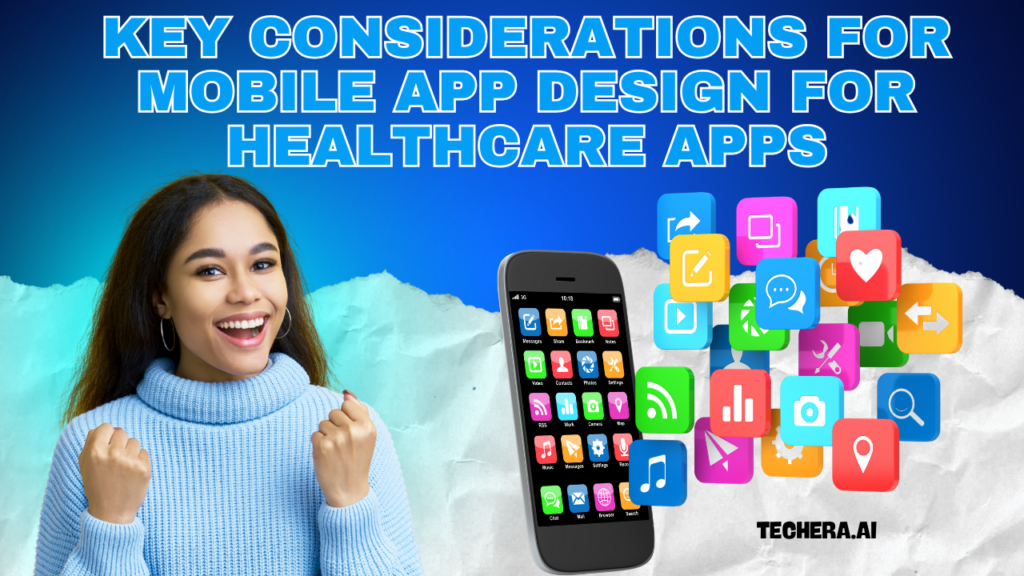
Explore the vital elements of Mobile App Design that ensure healthcare apps are user-friendly, secure, and compliant. Learn how thoughtful Mobile App Design improves patient engagement, safety, and trust in digital healthcare solutions.
Introduction
Healthcare is one of the most sensitive and critical sectors, and mobile app design have transformed the way patients and doctors interact. From telemedicine consultations to health tracking, these apps are making healthcare more accessible. But designing a healthcare app is not the same as designing an e-commerce or social media app. It requires a deep understanding of compliance, trust, accessibility, and user well-being. Let’s explore the key considerations every designer and developer must keep in mind when creating healthcare apps.
Understanding the Unique Nature of Healthcare Apps
Healthcare apps come in many forms: telemedicine platforms, electronic health records (EHR) apps, fitness trackers, mental health apps, and more. Each category has its own challenges. For example, a telemedicine app must ensure video stability and privacy, while a fitness app must encourage consistent user engagement. Designers need to identify the app’s primary purpose before working on the user interface and flow.
Prioritizing User Experience (UX) in Healthcare Apps
Unlike tech-savvy users of entertainment apps, healthcare app users range from young adults to elderly patients with limited digital literacy.
- Keep navigation simple and intuitive.
- Offer large buttons and readable fonts for older users.
- Provide multilingual support for diverse patient populations.
When in doubt, always prioritize clarity over complexity.
Data Security and Privacy Compliance

Nothing matters more than protecting patient data. Healthcare apps must comply with strict regulations like HIPAA (in the U.S.) or GDPR (in Europe).
- Use end-to-end encryption for all medical data.
- Implement multi-factor authentication to prevent unauthorized access.
- Clearly explain privacy policies in simple language.
Remember, trust is earned through transparency and strong security.
Personalization in Healthcare Apps
Personalization boosts user engagement.
- Patients may need health dashboards, while doctors need patient overviews.
- AI can provide personalized health recommendations.
- Adaptive design ensures that users only see what’s relevant to them.
This personal touch makes users feel that the app truly understands their needs.
Also Read : How to Optimize Mobile App Design for Faster Load Times
Designing for Trust and Transparency
In healthcare, trust can make or break an app.
- Avoid medical jargon; use clear and simple language.
- Provide consent forms that users can easily understand.
- Prevent information overload by highlighting key details first.
Think of the app as a friendly doctor—informative but approachable.
Integration with Wearables and IoT Devices
Many healthcare apps now integrate with smartwatches, fitness trackers, or IoT medical devices.
- Sync real-time health data like heart rate, sleep cycles, and glucose levels.
- Provide easy-to-read graphs and summaries.
- Ensure that device integration doesn’t compromise speed or accuracy.
The smoother the integration, the more valuable the app becomes.
Performance and Speed Optimization

A healthcare app must be fast and reliable, especially in emergencies.
- Optimize load times so users aren’t left waiting.
- Provide an offline mode for areas with poor connectivity.
- Keep the app lightweight by removing unnecessary features.
Performance can literally be a matter of life and death in healthcare.
Telemedicine and Virtual Care Features
Telemedicine has become the backbone of modern healthcare.
- Ensure HD video consultations without lag.
- Provide secure chat and messaging for patient-doctor communication.
- Add appointment reminders and scheduling to reduce no-shows.
A smooth telemedicine experience helps both doctors and patients save time and stress.
Accessibility and Inclusivity in Design
Healthcare must be accessible to everyone.
- Offer voice commands for visually impaired patients.
- Provide adjustable font sizes and high-contrast themes.
- Support screen readers for people with disabilities.
Inclusivity ensures no patient is left behind.
Gamification and Engagement Strategies
Healthcare doesn’t have to feel boring.
- Add health challenges (e.g., daily step goals).
- Offer rewards or badges for completing health tasks.
- Create community features for peer support.
These small design elements keep users motivated and consistent.
Error Handling and User Guidance
Errors in healthcare apps can cause panic if not handled properly.
- Provide clear error messages that guide users, not confuse them.
- Use step-by-step guides for complex processes like test result downloads.
- Include emergency buttons for urgent help.
A calm, reassuring mobile app design helps patients feel safe.
Testing and Continuous Improvement
Healthcare apps must be tested thoroughly before release.
- Conduct usability testing with real patients and doctors.
- Use A/B testing to refine features.
- Collect feedback regularly and update frequently.
A healthcare mobile app design is never “finished”; it should evolve with user needs.
Best Practices for Designers and Developers
To succeed in healthcare app design:
- Collaborate closely with medical experts.
- Keep design clean, functional, and human-centered.
- Balance visual appeal with performance and compliance.
At the end of the day, the goal is to improve lives—not just deliver a digital product.
Conclusion
Designing healthcare apps requires much more than good aesthetics. You need to balance usability, security, compliance, performance, and trust. By focusing on accessibility, personalization, telemedicine features, and continuous improvements, you can create an mobile app design that truly supports patients and healthcare providers. In healthcare, a well-Mobile App Design isn’t just convenient—it can save lives.
FAQs
1. What is the most important factor in designing healthcare apps?
Security and privacy should always come first, followed by usability and accessibility.
2. How can healthcare apps build user trust?
By being transparent with data usage, offering clear communication, and following regulations like HIPAA and GDPR.
3. Why is accessibility so critical in healthcare app design?
Because patients of all ages and abilities need to use these apps without barriers.
4. Should healthcare apps integrate with wearables?
Yes, as it allows real-time health tracking and improves patient engagement.
5. How often should healthcare apps be updated?
They should be updated regularly to fix bugs, improve security, and adapt to user feedback.

